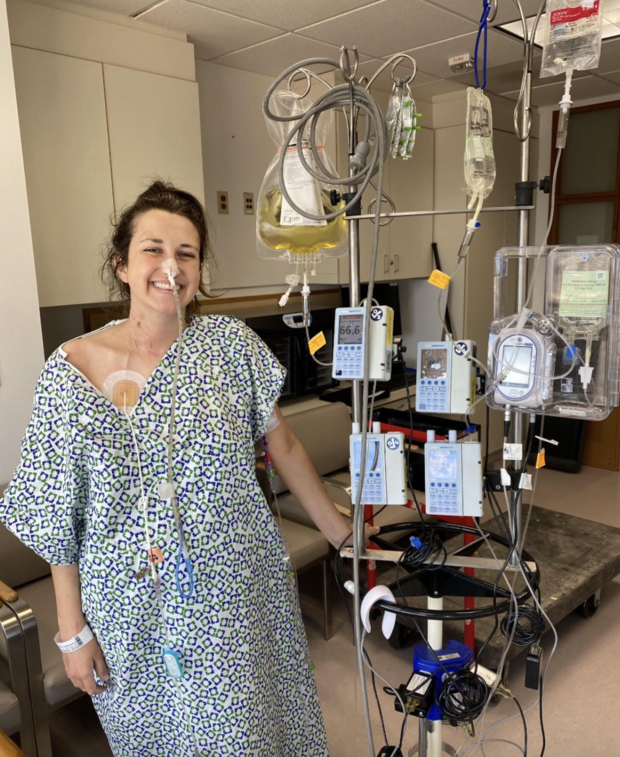At 24, Danielle Perea had just enrolled in a master’s degree in clinical laboratory science program, was living with her boyfriend in Louisiana, and was generally enjoying her life — until one day a stomach ache led her to going to an area hospital, where he was told he only had a few hours to live.
Just a few days into her program, Perea woke up with a “severe stomach ache” that she initially mistook for food poisoning, but when she went to the bathroom, she flushed out ” frothy blood” that sent her to the emergency room of a hospital she did not name due to pending litigation. Perea was told that a scan by doctors showed no signs of a problem.
When her symptoms persisted, she went to another hospital where she was observed again, but no diagnosis was made. Doctors reviewed the same scan and said it was unlikely that a clot had formed due to her age and relative health. On the third day of her symptoms, Perea began vomiting blood and returned to the emergency room as her symptoms intensified.
Exploratory surgery revealed a blood clot in one of the vessels carrying blood from the small intestine, a condition called mesenteric ischemia. Surgeons tried to salvage the organs, but found too much dead tissue.
“They just saw that everything was completely black, necrotic, dead,” Perea told CBS News. “They (told my boyfriend) ‘There’s no way she’s going to survive this, you need to call her parents. Get anyone here that needs to be here because she probably has 24 years left hours to live.'”
Danielle Perea
Perea was admitted to hospice care but exceeded expectations, maintaining “strong vital signs” for more than a week. Meanwhile, her mother and boyfriend were looking for a miracle. They heard about the Cleveland Clinic’s intestinal transplant program, the largest in the country, and the program’s director, Dr. Kareem Abu-Elmagd, agreed to take Perea’s case.
What is an intestinal transplant and why are they so rare?
An intestinal transplant replaces the small intestine with a new organ. Only 95 were performed in the United States last year, according to Dr. Masato Fujiki, director of the intestinal transplant service at the Cleveland Clinic and one of the doctors who treated Perea. Eighteen of these transplants were performed at the Cleveland Clinic, making it the largest intestinal transplant program in the country. During the same period, more than 10,000 liver transplants and more than 4,000 heart transplants were performed.
Each year, there are approximately 15,000 eligible organ donors, and few patients are eligible for intestinal transplantation. This allows doctors to be “very selective, to get the best organ,” Fujiki said. Ideal intestinal donors are people under the age of 50, in good health and with stable blood pressure.
Although it is not particularly difficult to find a suitable organ, intestinal transplants did not have a high success rate until recently, which contributes to their scarcity, Fujiki said. The intestines are a “difficult” organ to monitor, he said, and intestinal transplants have the highest rejection rate of any type of organ transplant.
The one-year graft survival rate for an intestinal transplant patient reached 82% in 2022, compared to a rate of 76.2% in 2018, according to national data. That’s still lower than the graft survival rate for more common procedures like liver transplants, which have a rate of 85 to 90 percent, Fujiki said.
A long road to recovery
Once Perea’s family learned of the intestinal transplant program and her case was accepted at the Cleveland Clinic, she was brought to the Ohio hospital. His small intestine was almost completely resected. Her condition stabilized and, after several more procedures, she was officially added to the transplant list in spring 2019.
Before the transplant, Perea spent a year and a half living on intravenous nutrition, because without her intestines, she couldn’t eat normally. The time she spent on machines forced Perea to undergo another surgery to repair the damage to her trachea before she could receive the transplant, extending the wait time. The coronavirus pandemic also complicated the process, forcing her to pass on an organ in April 2020.
Danielle Perea
Finally, in June 2020, Perea received the call she had been waiting for.
“They would just say, ‘You need to get to the clinic right away.’ That was not an option,” Perea said.
The surgery took 10 hours, and even after the new organ was in place, Perea continued to spend time in the hospital, being readmitted for frequent fevers. In January 2021, she underwent another procedure to repair her abdominal wall and reverse her ileostomy, an incision made during the surgery.
Now, four years after the surgery, she told CBS News that she’s able to live a relatively normal life, despite taking “about 40 pills a day.” She may need a kidney transplant in the future, due to the impact of anti-rejection drugs on that organ, and she has annual appointments at the Cleveland Clinic to monitor the transplant, but so far, everything has been “completely normal.”
“I have no restrictions. My incisions healed well. I got married in November,” Perea said. “We bought a house. Everything is fine.”
At the Cleveland Clinic, she said, “they say, ‘Just keep living your life. There’s no stopping you.'”
Danielle Perea


